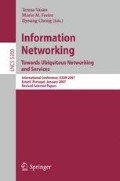Abstract
Measurement studies on the Internet topology show that connectivities of nodes exhibit power–law attribute, but it is apparent that only the degree distribution does not determine the network structure, and especially true when we study the network–related control like routing control. In this paper, we first reveal structures of the router–level topologies using the working ISP networks, which clearly indicates ISP topologies are highly clustered; a node connects two or more nodes that also connected each other, while not in the existing modeling approaches. Based on this observation, we develop a new realistic modeling method for generating router–level topologies. In our method, when a new node joins the network, the node likely connects to the nearest nodes. In addition, we add the new links based on the node utilization in the topology, which corresponds to an enhancement of network equipments in ISP networks. With appropriate parameters, important metrics, such as the a cluster coefficient and the number of node-pairs that pass through nodes, exhibit the similar value of the actual ISP topology while keeping the degree distribution of resulting topology to follow power–law.
Access this chapter
Tax calculation will be finalised at checkout
Purchases are for personal use only
Preview
Unable to display preview. Download preview PDF.
References
Faloutsos, M., Faloutsos, P., Faloutsos, C.: On power–law relationships of the Internet topology. In: Proceedings of ACM SIGCOMM, pp. 251–262 (1999)
Gkantsidis, C., Mihail, M., Saberi, A.: Conductance and congestion in power law graphs. In: Proceedings of ACM SIGMETRICS, pp. 148–159 (2003)
Barabasi, A., Albert, R.: Emergence of scaling in random networks. Science 286, 509–512 (1999)
Li, L., Alderson, D., Willinger, W., Doyle, J.: A first–principles approach to understanding the Internet’s router–level topology. ACM SIGCOMM Computer Communication Review 34(4), 3–14 (2004)
Sprint, N., Mahajan, R., Wetherall, D., Anderson, T.: Measuring ISP topologies with rocketfuel. IEEE/ACM Transactions on Networking 12(1), 2–16 (2004)
Bu, T., Towsley, D.: On distinguishing between Internet power law topology generators. In: Proceedings of INFOCOM, pp. 1587–1596 (2002)
Milo, R., Shen-Orr, S., Itzkovitz, S., Kashtan, N., Cheklovskii, D., Alon, U.: Network motifs: Simple building blocks of complex networks. Science, 824–827 (2002)
Erdös, P., Rényi, A.: On the evolution of random graphs. Publications of the Mathematical Institute of the Hungarian Academy of Sciences 5, 17–61 (1960)
Albert, R., Barabási, A.L.: Statistical mechanics of complex networks. Reviews of Modern Physics (2002)
Newman, M.E.J.: 2. In: Random graphs as models of networks, pp. 35–68. Wiley, Chichester (2002)
Fabrikant, A., Koutsoupias, E., Papadimitriou, C.H.: Heuristically optimized trade–offs: A new paradigm for power law in the Internet. In: Widmayer, P., Triguero, F., Morales, R., Hennessy, M., Eidenbenz, S., Conejo, R. (eds.) ICALP 2002. LNCS, vol. 2380, pp. 110–122. Springer, Heidelberg (2002)
Alvarez-Hamelin, J.I., Schabanel, N.: An Internet graph model based on trade–off optimization. European Physical Journal B 38(2), 231–237 (2004)
Fratta, L., Gerla, M., Kleinrock, L.: The flow deviation method: An approach to store-and-forward communication network design. Networks 3, 97–133 (1973)
Fukumoto, R., Arakawa, S., Murata, M.: On routing controls in ISP topologies: A structural perspective. In: Proceedings of Chinacom (2006)
Author information
Authors and Affiliations
Editor information
Editors and Affiliations
Rights and permissions
Copyright information
© 2008 Springer-Verlag Berlin Heidelberg
About this paper
Cite this paper
Fukumoto, R., Arakawa, S., Takine, T., Murata, M. (2008). Analyzing and Modeling Router–Level Internet Topology. In: Vazão, T., Freire, M.M., Chong, I. (eds) Information Networking. Towards Ubiquitous Networking and Services. ICOIN 2007. Lecture Notes in Computer Science, vol 5200. Springer, Berlin, Heidelberg. https://doi.org/10.1007/978-3-540-89524-4_18
Download citation
DOI: https://doi.org/10.1007/978-3-540-89524-4_18
Publisher Name: Springer, Berlin, Heidelberg
Print ISBN: 978-3-540-89523-7
Online ISBN: 978-3-540-89524-4
eBook Packages: Computer ScienceComputer Science (R0)

